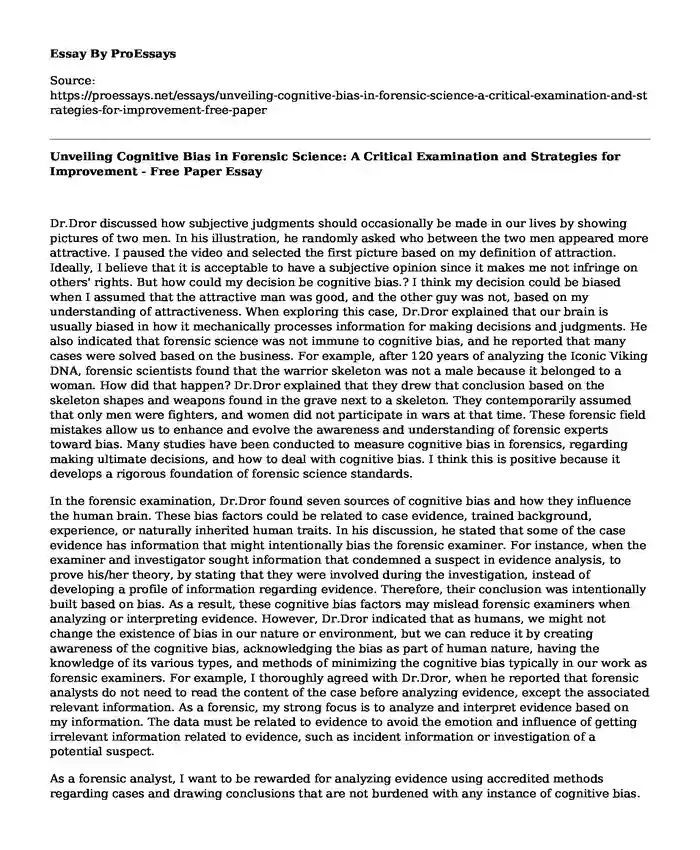Dr.Dror discussed how subjective judgments should occasionally be made in our lives by showing pictures of two men. In his illustration, he randomly asked who between the two men appeared more attractive. I paused the video and selected the first picture based on my definition of attraction. Ideally, I believe that it is acceptable to have a subjective opinion since it makes me not infringe on others' rights. But how could my decision be cognitive bias.? I think my decision could be biased when I assumed that the attractive man was good, and the other guy was not, based on my understanding of attractiveness. When exploring this case, Dr.Dror explained that our brain is usually biased in how it mechanically processes information for making decisions and judgments. He also indicated that forensic science was not immune to cognitive bias, and he reported that many cases were solved based on the business. For example, after 120 years of analyzing the Iconic Viking DNA, forensic scientists found that the warrior skeleton was not a male because it belonged to a woman. How did that happen? Dr.Dror explained that they drew that conclusion based on the skeleton shapes and weapons found in the grave next to a skeleton. They contemporarily assumed that only men were fighters, and women did not participate in wars at that time. These forensic field mistakes allow us to enhance and evolve the awareness and understanding of forensic experts toward bias. Many studies have been conducted to measure cognitive bias in forensics, regarding making ultimate decisions, and how to deal with cognitive bias. I think this is positive because it develops a rigorous foundation of forensic science standards.
In the forensic examination, Dr.Dror found seven sources of cognitive bias and how they influence the human brain. These bias factors could be related to case evidence, trained background, experience, or naturally inherited human traits. In his discussion, he stated that some of the case evidence has information that might intentionally bias the forensic examiner. For instance, when the examiner and investigator sought information that condemned a suspect in evidence analysis, to prove his/her theory, by stating that they were involved during the investigation, instead of developing a profile of information regarding evidence. Therefore, their conclusion was intentionally built based on bias. As a result, these cognitive bias factors may mislead forensic examiners when analyzing or interpreting evidence. However, Dr.Dror indicated that as humans, we might not change the existence of bias in our nature or environment, but we can reduce it by creating awareness of the cognitive bias, acknowledging the bias as part of human nature, having the knowledge of its various types, and methods of minimizing the cognitive bias typically in our work as forensic examiners. For example, I thoroughly agreed with Dr.Dror, when he reported that forensic analysts do not need to read the content of the case before analyzing evidence, except the associated relevant information. As a forensic, my strong focus is to analyze and interpret evidence based on my information. The data must be related to evidence to avoid the emotion and influence of getting irrelevant information related to evidence, such as incident information or investigation of a potential suspect.
As a forensic analyst, I want to be rewarded for analyzing evidence using accredited methods regarding cases and drawing conclusions that are not burdened with any instance of cognitive bias. However, that may not be the case in reality. I was surprised that forensic experts are awarded, based on the number of cases they solve, by identifying ID or how pretty good they seem, by convincing the jury of the science behind their conclusions. I think it is a disappointment because forensic science domains are working to enhance and improve the field far from bias and error.
Conclusion
In conclusion, Dr.Dror, from his work and published journals, tried to articulate the definition of cognitive bias, its different types, and ways to reduce it in forensic science. I believe in the importance of expanding our knowledge and learning how to improve our performance as forensic scientists to avoid terrible mistakes during our work.
Cite this page
Unveiling Cognitive Bias in Forensic Science: A Critical Examination and Strategies for Improvement - Free Paper. (2023, Dec 13). Retrieved from https://proessays.net/essays/unveiling-cognitive-bias-in-forensic-science-a-critical-examination-and-strategies-for-improvement-free-paper
If you are the original author of this essay and no longer wish to have it published on the ProEssays website, please click below to request its removal:
- Making Successful College Students
- Postgraduate Dentistry Personal Statement
- Ken Robinson's Presentation on "Do Schools Kill Creativity" Analysis Essay
- Article Analysis Essay on Teachers, Social Media, and Free Speech
- Psychological and Behavioral Effects of Poor Parenting on Children - Research Paper
- Essay Example on School Health: The Essential Link Between Learning and Wellbeing
- Essay Example on Stereotypes: A Threat to Student Performance?







